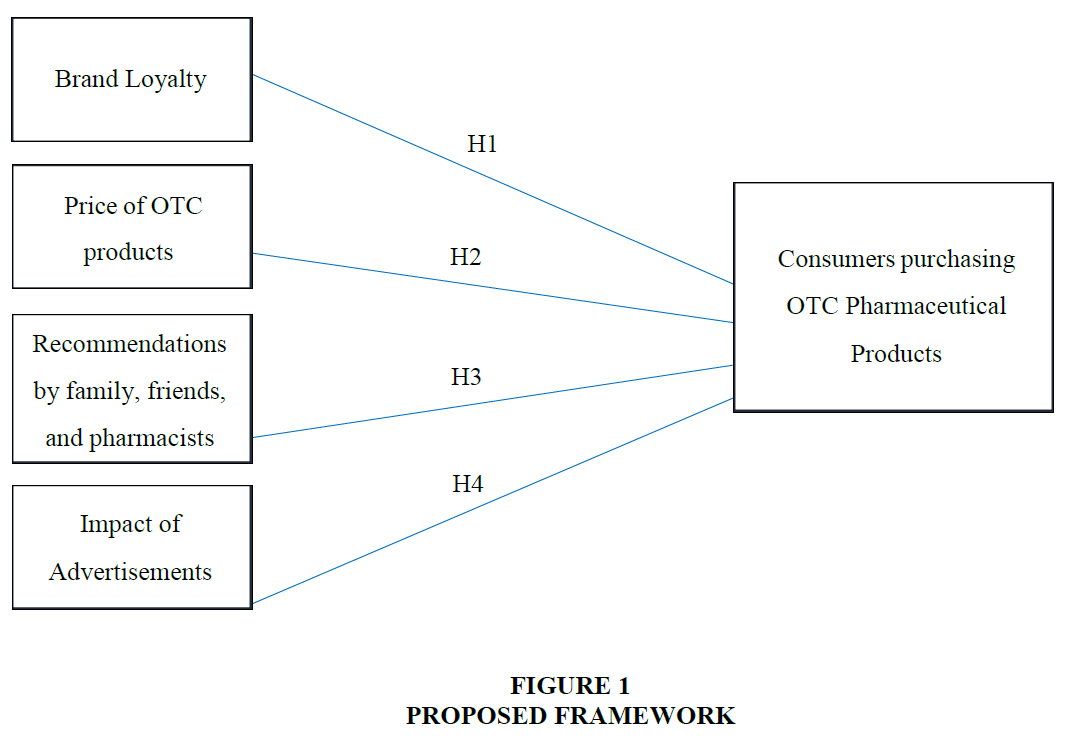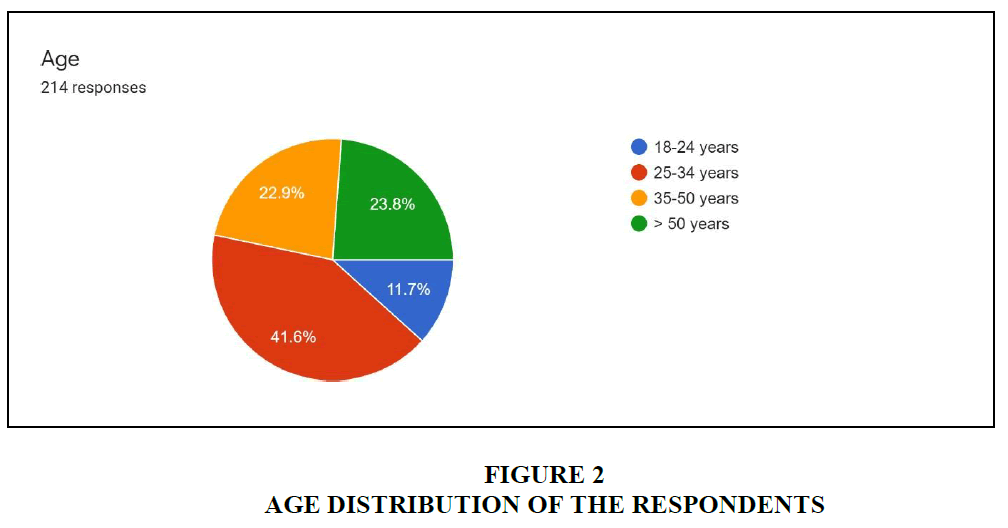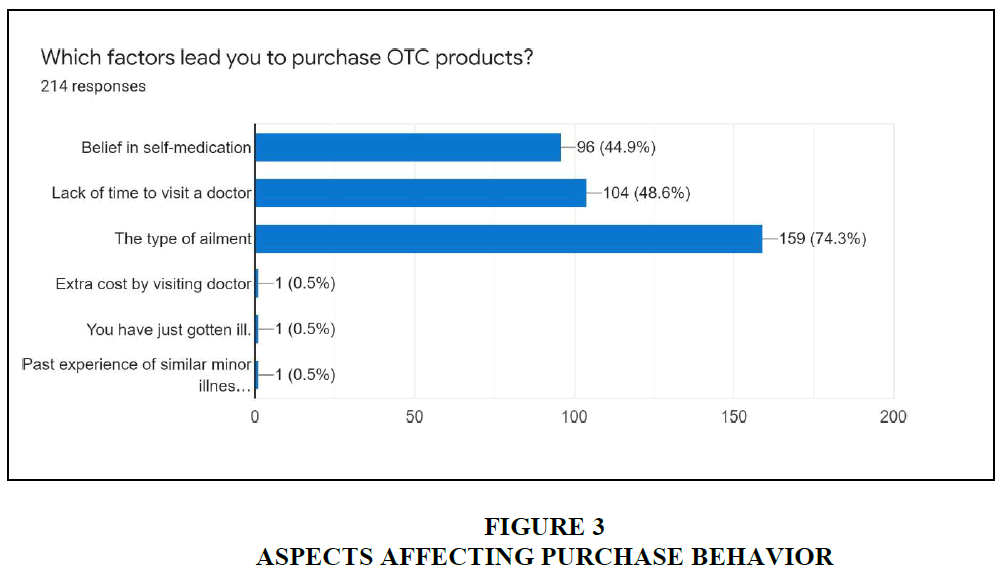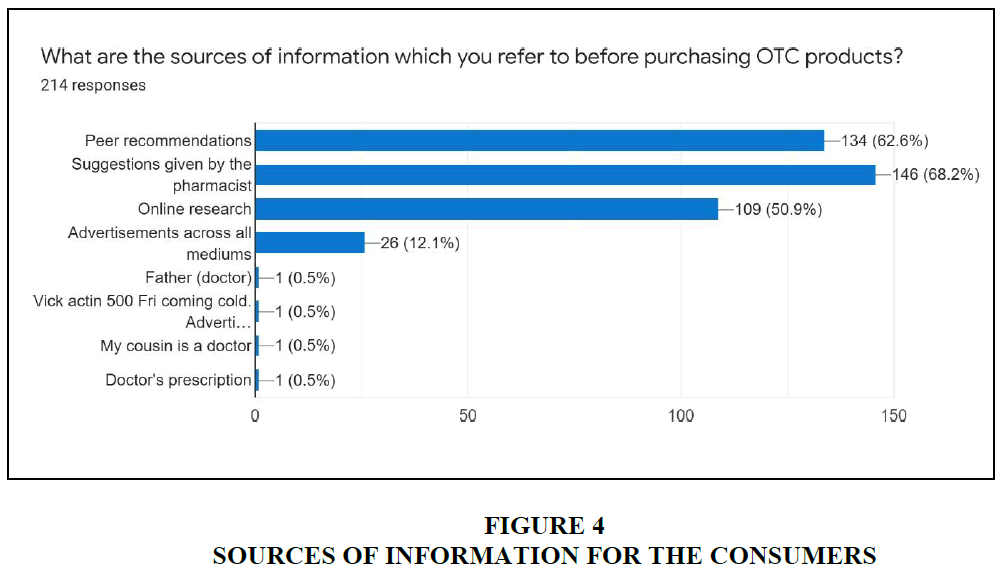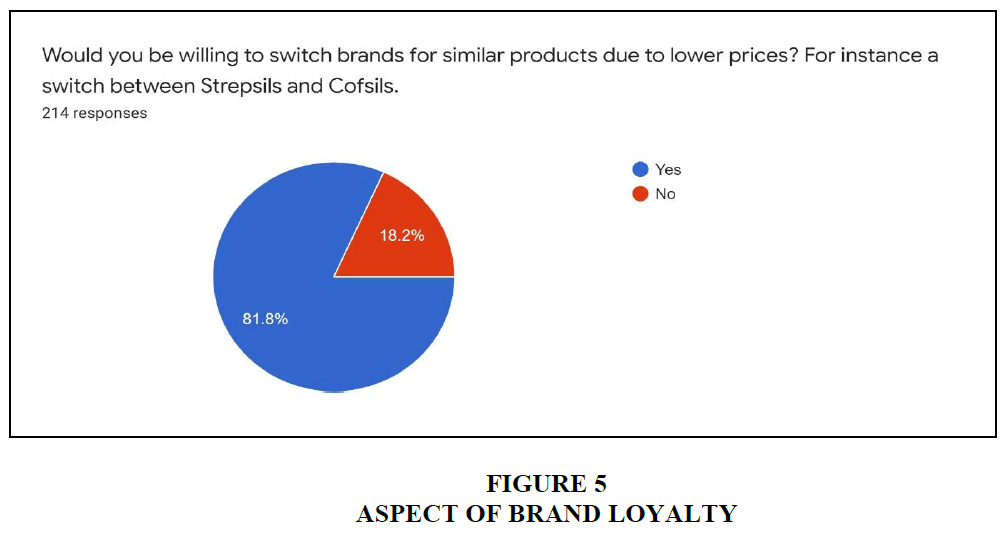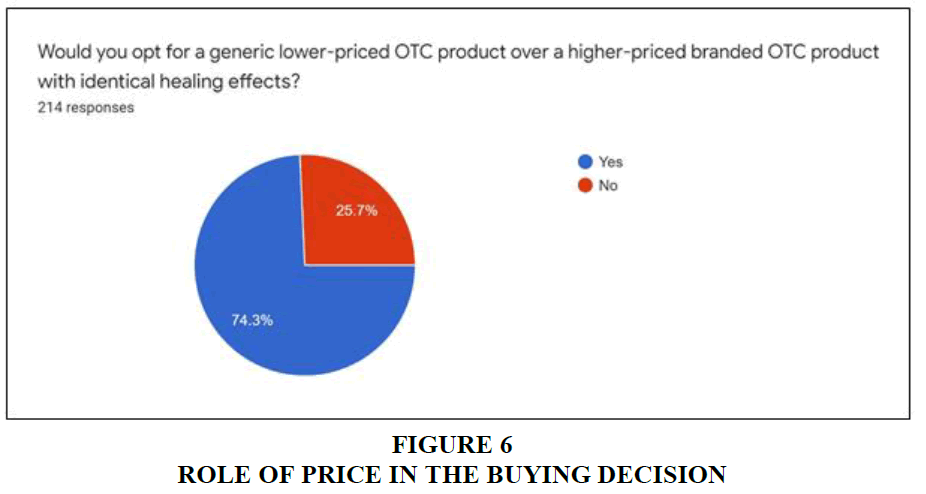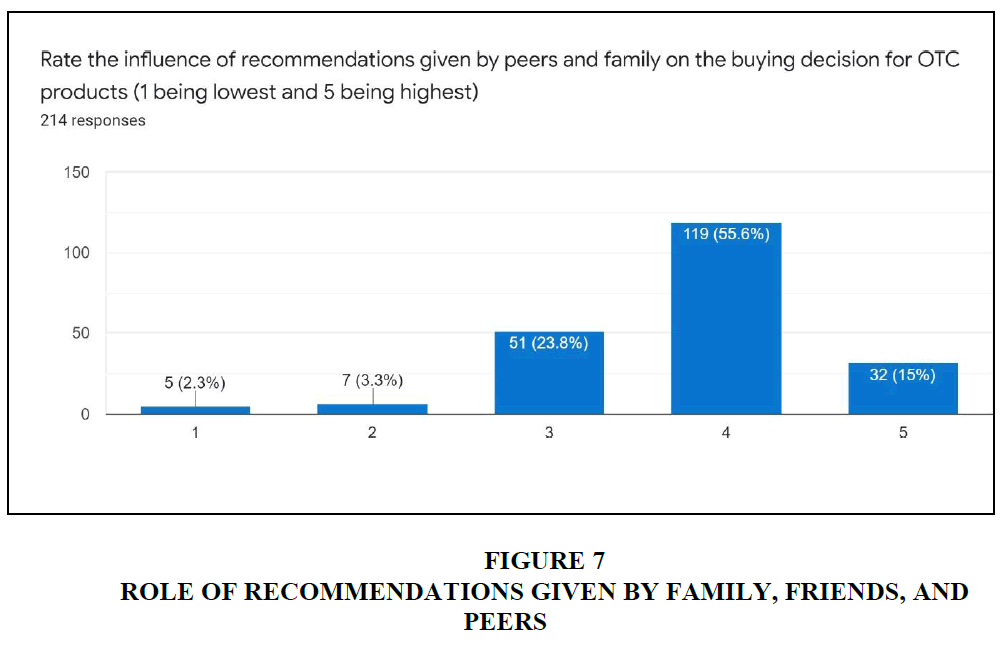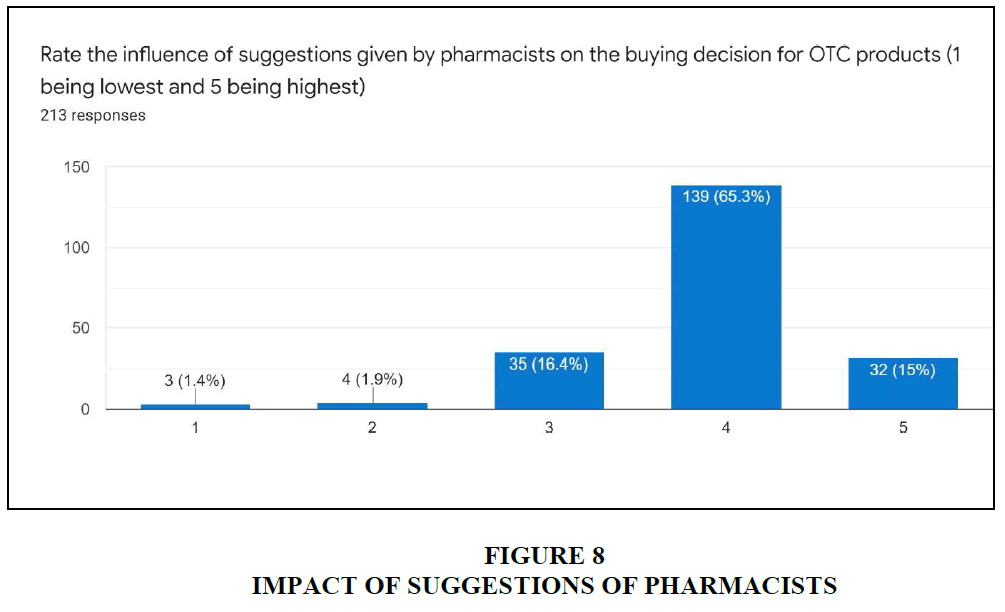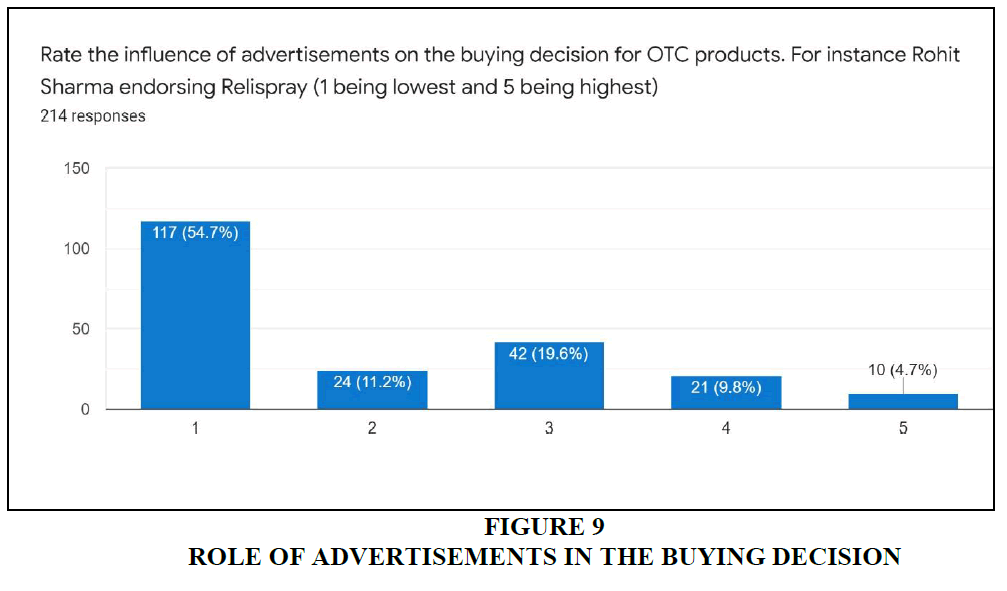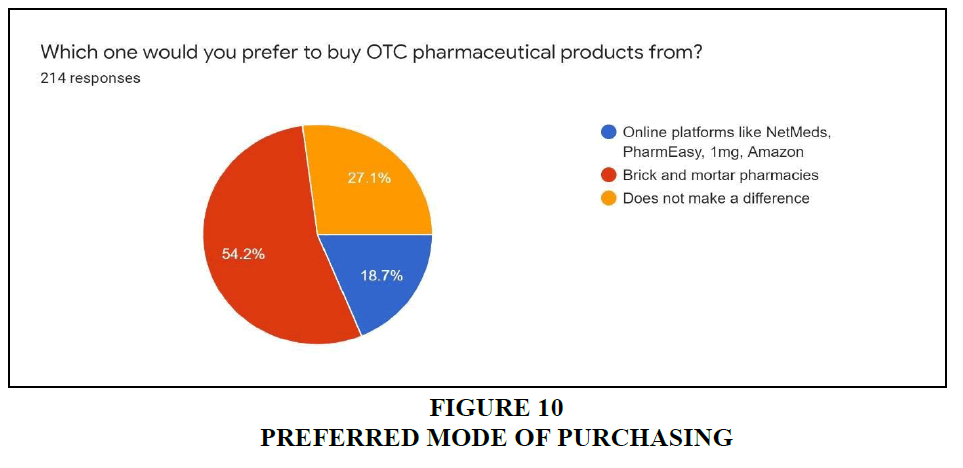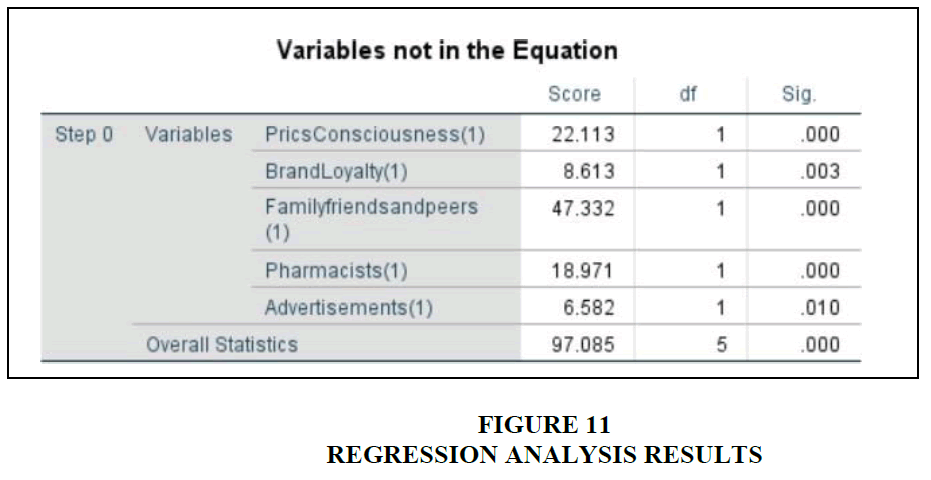Review Article: 2024 Vol: 28 Issue: 3
An Investigation of the Factors that Impact Consumer Behavior in Relation to Over-the-Counter Pharmaceutical Products
Richa Pandey, Galgotias University and Sharda University
Md. Chand Rashid, Galgotias University
Citation Information: Pandey R., & Rashid Khan, MD. (2024). An investigation of the factors that impact consumer behavior in relation to over-the-counter pharmaceutical products. Academy of Marketing Studies Journal, 28(3), 1-18.
Abstract
In recent times, there has been a significant interest in the segment of over-the-counter (OTC) medicines due to the rise of healthy living and increased health consciousness among consumers, both in terms of physical and mental well-being. The objective of this research is to comprehend the influence that these elements exert on customers’ decision-making processes on the purchase of such products. The study investigates the elements that influence customers’ ultimate purchasing decisions for over-the-counter (OTC) drugs. Hence, the main goal is to comprehend the influence of variables such as brand loyalty, price sensitivity, recommendations from family, friends, peers, pharmacists, and marketing across various platforms on consumers’ decision-making process. The research will be carried out using a questionnaire that will be completed by individuals from diverse age groups and backgrounds nationwide. The study will utilize the theory of planned behavior to examine the influence of important elements such as brand loyalty, price sensitivity, recommendations from social groups, and the impact of commercials. Due to the utilization of convenience sampling, there is a possibility of an uneven distribution of respondents across different age groups and geographical locations. The results confirm that brand loyalty does not provide significant information regarding OTC drugs. Price sensitivity is a significant factor that impacts customers’ decision-making. The recommendations provided by the associate group play a pivotal influence in shaping consumers’ purchasing decisions. The influence of commercials was determined to be rather inconclusive, given customers’ emphasis on immediate alleviation and the impulse to make a purchase prompted by the pain or need in the current conditions. Additional variables, such as information sources and purchasing methods (offline or online), were also taken into account during the investigation.
Keywords
OTC, Over-The-Counter Medicines, Pharma, Theory of Planned Behaviour, Brand loyalty, Price Sensitivity, Recommendations, Advertisements.
Introduction
The Over-the-Counter (OTC) Pharmaceutical market comprises over-the-counter medicines that do not require a medical prescription to be bought (Habash et al., 2020; Ray et al., 2022). The market is classified into analgesics, cold and cough remedies, digestive and intestinal medication, skin treatment products, and vitamins and minerals. Products sold exclusively in pharmacies and those that can be bought anywhere else are both included. Transactions made by hospitals are not considered (Adhikari et al., 2021; Wilson and Ralphs, 2023). The global OTC drugs market is valued at USD 311 billion by 2028 and is projected to rise at a CAGR of 8.55% in the next 5 years (2023-2028). Consumer healthcare is mainly made up of two segments: 1) Rx-to-OTC segment, i.e., brands that started as prescription medicines but, over time, evolved into the self-medication category. For instance, Crocin and Volini. 2) The pure OTC segment consists of non-Rx brands developed via direct-to-consumer marketing, for instance, brands like Vicks and Volini (Mohapatra and Zhang, 2020).
The brand-driven product-based portfolio (Relatively Lesser Therapeutic Value) consists of health-focused products characterized by brand-driven, high awareness, and direct sales distinguished by the likes of pain relief, cosmetics, and tablets. The property-based products (Wholly Therapeutic Value), characterized by value-driven, HCP department, and indirect sale, though OTC, are mainly sold via a healthcare practitioner’s prescription. These include the likes of nutraceuticals, laxatives, and dietary supplements. With changing times, consumers are evolving the world over. Internet and technology have increased the pace of our lives manifold, and this has also led to a rise in average stress levels. Environmental changes and the pressure to adapt to a dynamic lifestyle with compact living spaces, various types of pollution, stressful professional lives, fast-changing technology, and predominantly sedentary lifestyles have contributed to the prevalence of headaches, stress, hypertension, backache, acidity, and increased sensitivity (Crane et al., 2011; Ismail and Ahmad, 2015).
The rising adoption rate of OTC drugs in developing economies like Brazil, China, and India has led to a higher market growth and penetration rate. The advent of e-pharmacies has boosted the concept of getting medicines delivered to the home, which has increased the convenience and accessibility for consumers. The increasing focus of the public and private sector on the healthcare sector has also contributed immensely to the growth of the OTC sector (Srivastava et al., 2018). The pro-active approach of consumers towards self-medication in recent times due to greater awareness and the rise of the internet age has been a major driver towards the expansion of the OTC market globally (Ray, 2004). In India, from the perspective of a consumer, a number of reasons are fueling the growing interest in self-medication, including unwillingness or inability to pay doctors’ fees, paucity of time to visit doctors, better awareness of health issues, and a rising significance of preventive health measures (Ensor & Cooper, 2004; Hossain, 2016). From the government’s perspective, self-medication has the potential to decrease the burden on public health services (Thuan et al., 2008; Noone and Blanchette, 2018). The creation of an efficient self-medication culture demands a robust regulatory system to ensure consumer safety and trust (Fainzang, 2016). The lack of such a framework is a significant obstacle to the evolution of self-medication in India. The consideration of a proposal to introduce a properly sized “unit dose packaging” and “adequate labeling” by a sub-committee of India’s drugs regulatory authority highlights the desire to ensure the safe development of self-medication in the country (Money Control, 2019).
The revenue of the global OTC Pharmaceuticals market is estimated to touch 212 billion USD in 2025 from 184 billion USD in 2022. Projected to grow annually at a CAGR of 26 percent between 2023 and 2028, the market will touch new heights in the period from 2021-2025, making it a promising scenario for pharma companies (Statista, 2023a). Based on various national laws and healthcare dictums, the utilization of OTC pharmaceuticals and the buying behavior of consumers tend to vary depending on the geographical location (Srivastava and Wagh, 2017). The global development in healthcare methods has directly created an impact on the expansion of the OTC market. As a generic principle, the greater the availability of a medicine, the higher the consumption. According to a report by Statista, revenue in OTC in the USA earned 37.6 billion USD, in China $28.5 billion, and in Sweden 653 million USD (Statista, 2023b).
The offline channel dominates OTC sales, and it is projected that by 2025, 15% of sales will take place through the online channel, whereas in 2020, offline sales will be 88%. The drivers for the global OTC pharmaceutical market are the rising adoption rate of OTC drugs in developing economies, affordability as a result of the influx of innovative drugs in the market due to technological advancement and the increasing health consciousness among people, increasing focus of public and private organizations on R&D activities for developing effective drug delivery systems. A few challenges that affect the growth of the OTC market are the incorrect medication or dosage due to improper self-diagnosis leading to health complications, misuse of drugs leading to drug abuse or addiction is another major challenge (Bond, C., & Hannaford, 2003; Temechewu and Gebremedhin, 2020; Jo et al., 2022). Overall, the age of data and the internet has enabled consumers to access a wide variety of data on ailments and medication, and this has led to a rise in self-medication (Agarwal et al., 2021; Yousef et al., 2008). People tend to research any disorder that they or their loved ones suffer from before consulting an expert. Johnson and Johnson, Novartis, Bayer, GlaxoSmithKline, Sanofi, and Pfizer are some of the major players in the OTC pharmaceuticals market.
Indian Context
The revenue in the Indian OTC Pharmaceuticals market is projected to reach USD 6.97 billion in 2023. Projected to grow annually at a CAGR of 7.85% from 2023 to 2028 (Statista, 2023), the market will touch new summits. India is one of the largest markets worldwide in the OTC drugs space. The OTC medicines revenue share constitutes 21%, 9% patented drugs of the Indian market, which is dominated by generic drugs (70%). Increasing health expenditure due to the pandemic, a sudden rise in lifestyle diseases, and India’s massive population make it a promising market for the future (Yeganeh, 2019). Some of the important market drivers that are fueling the market growth are rising disposable incomes coupled with increasing levels of health consciousness, a rise in awareness regarding the frugality of self-treatment and OTC medication, the growing population rate, including the rising middle class in the country comprises a significant segment of the population willing to use OTC medicines (World Health Organization, 2012).
Analgesics comprised a major component of the total value of the over-the-counter (OTC) medication segment. OTC analgesics are used to treat fever, headache, musculoskeletal injuries and disorders, arthritis, and menstrual cramps, which have led to a rise in total market consumption. Other issues, like obesity, stress, and lifestyle disorders, tend to cause chronic pain and various types of aches, which require long-term treatment. Sun Pharma, Dr. Reddy’s Laboratories, Cipla, Lupin, Aurobindo Pharma, and Zydus Cadila are among some of the major Indian players in addition to the international players like P&G, Johnson and Johnson, GlaxoSmithKline and Pfizer in the Indian OTC pharmaceutical market.
India’s production expenditure is nearly one-third of that of the USA. This is due to labor costs being 50–55% less compared to the Western countries, and the expenditure incurred for establishing a production plant in India is 40% less compared to developed nations like the USA. India’s large population with a high combined market potential has conventionally been reliable as a robust source of consumption for sectors like retail, FMCG, and electronics. Also, in spite of boasting of a significant and highly mature pharmaceutical industry, the per-capita expenditures on healthcare in India are amongst the lowest globally (Ray et al., 2019; Patrick et al., 2022). This is mainly due to the fact that the majority of the expenditure is directly out of pocket. There has been a rise in the R&D expenditure by Indian companies in recent years. The OTC market holds great potential in India, and with growing awareness and favorable consumption trends with respect to healthcare, the future seems to hold a lot of promise for this sector in the country.
Motivation of Research
With the advent of healthy living, both from a physical and mental point of view and an increasing level of health consciousness among today’s consumers, the segment of OTC medicines has been of great interest in recent times. With a sea of information regarding all types of medicines freely available on the internet, people today have access to more data than ever before. This has also led to a rise in self-medication and home remedies. In addition to this, the hectic lifestyles led by today’s generation lead to a lack of time to visit doctors for minor illnesses, which encourages them to indulge in OTC medication. The motive of this research is to understand the impact that such factors have on the decision-making of consumers when it comes to buying such products. The research will be conducted through a questionnaire, which will be filled by people across the country from various age groups and backgrounds. The impact of crucial factors like brand loyalty, price consciousness, recommendations given by the associative group, and the impact of advertisements will be studied through the responses. As the type of sampling method used is convenience sampling, there may be more respondents from a specific age group and a certain geography than others.
The second chapter is the Literature Review, which explains all the concepts that are crucial in comprehending consumer behavior throughout the decision-making journey. The third chapter is the industry analysis both from a global and Indian context. A thorough industry analysis helps us analyze the various internal and external elements that can be considered while evaluating the situation for consumers buying OTC medicines. The fourth chapter explains the research hypotheses that have been considered based on the factors influencing consumers’ buying decisions. The fifth chapter is about the research methodology used to obtain the responses and the sampling technique involved in it. The sixth chapter explains the data analysis and interpretation of the inferences drawn through the results. The seventh chapter deals with the conclusion of the study and the future scope for research in this field. With the rising levels of health consciousness and the abundance of data coupled with the lack of time due to the hectic lifestyles prevalent today, OTC medicines are going to represent a growing market in the future as well. Thus, comprehending the various aspects of consumer behavior related to this field is extremely crucial for all the pharmaceutical companies as well as the marketers associated with them.
Literature Review
Theory of Planned Behavior
Jinnah et al. (2020) highlighted the dynamism of global medication schedules due to the consistent launching of new and generic medicines, which provide a variety of medicines to customers in pharmacies. The Over-the-Counter medicines market always faces a certain amount of scrutiny due to its basic principle of self-medication. In this study, the primary psychological factors like attitude, subjective norms, perceived behavioral control, and perceived risk are observed in consumers as the elements controlling the OTC medicines buying behavior (Jinnah et al., 2020). It considers the extended theory of planned behavior to quantify the research constructs. Exploratory Factor Analysis and Structural Equation Modelling techniques have been used for data analysis. The results depicted that customers’ attitudes, subjective norms, and perceived behavioral control towards OTC medicine were of high importance, whereas perceived risk was of moderate influence.
Internal and External Factors
Habash and Al-Dmour (2020) aimed to determine the elements (internal and external) that act as a precursor and impact the decision to purchase over-the-counter (OTC) medicines in Jordan. A theoretical structure was created based on the purchasing behavior of consumers. A computable perspective and a convenience sampling method were utilized to garner data through questionnaires submitted by 351 respondents from certain Jordanian universities. The results show that all antecedent factors (internal, external, and combined) have a great impact on the decision to purchase OTC medicines. Internal elements create more impact than external elements, but a mixture of internal and external elements had the highest impact on purchasing OTC medicines (Habash and Al-Dmour, 2020).
Impacting Factors based on Location
Manik et al. (2021) examine the factors influencing the decision to buy Over-the-Counter drugs in Bangladesh. Over-the-counter medicines have materialized as drugs of grave misuse across the country. Coupled with self-medication, most of the drug store salespersons illicitly play a part in the advocacy and selling of prescription-only medicines in Bangladesh (Babu, 2008). The major factors attributed to this are previous encounters with drugs, the brand image of the pharmaceutical company, the brand identity of the drug, trivial side effects, and prior speculation regarding the drug to be utilized for the illness. In Bangladesh, advertising activities for pharmaceutical products based on mass media are strictly forbidden. Hence, the companies have to depend entirely on the sales force and physicians for promotional activities (Babu, 2008; Manik et al., 2021).
A Quantitative and Qualitative Approach
Srivastava & Wagh (2017) carried out exploratory research based on primary data garnered through a questionnaire to analyze the elements influencing consumer buying characteristics for pharmaceutical products. The sample size consisted of 100 people from Mumbai, Nashik, and Pimpalgaon. Aspects affecting consumer buying characteristics are assessed based on quantitative and qualitative methods. Influencers, product aesthetics, promotion, and cost came out as the major factors. Peer suggestions and user testimonials have a substantial impact as well. Price, convenience, and attainability are the most crucial elements. The brand image also has an impact on consumer perception while purchasing OTC pharmaceutical products (Srivastava & Wagh, 2017).
Importance of Familiarity in Purchasing OTC Medicines
Dadhich and Dixit (2017) carried out a cross-sectional study for a sample size of 100 consumers in Jaipur to analyze consumer behavior toward the purchase of OTC medicines. The data was gathered through surveys and interviews. The analysis was done using the SPSS software. Pharmacists play a crucial role in giving information about new OTC products. The inference was that most of the consumers were affected by familiarity with the OTC brand, and this element played a huge role in building loyalty and repeat purchases conducted a study to analyze consumers’ inclinations in selecting pharmacies and over-the-counter (OTC) drugs. A cross-sectional study was carried out with a sample size of 164 participants in Magelang, Indonesia. A structured questionnaire was utilized for collecting data. Data was analyzed through the SPSS software, which was used to conduct a Chi-Square test with a descriptive statistics approach. The conclusion was that while buying over-the-counter medicines, consumers give significance to product advertisements, peer suggestions, and the brand image (Pribadi et al., 2020)
Ting et al. (2019) created a model to comprehend the connection between the myriad factors that impact pharmaceutical purchase decisions and the consumer perception of these factors. In-depth interviews were conducted among 160 people in Malaysia to gather data for the process. The study finds that personal factors and the environment around them govern consumer decisions. It suggests that consumer decision-making would be better realized through a holistic view of the entire process.
Impact of Social Media Advertising
They researched to understand the role of social media advertising on the purchase behavior of customers with respect to OTC products in Egypt. The research was conducted to assist pharmaceutical marketers in understanding the impact of social media advertising as an advertising channel in influencing consumers’ buying decisions. A cold and flu product was advertised using the medium of Facebook. The independent variables in the study were the consumer perception of Facebook as an advertising medium, celebrity endorsement, and digital word of mouth. The dependent variable was the intention of Egyptian consumers to purchase the Cold and Flu products promoted on Facebook. A close-ended questionnaire was used to collect data, and a stepwise regression test was conducted to assess the data. The results depicted that digital word of mouth had the highest impact on shaping consumers’ decisions when it came to purchasing OTC medicines in Egypt. Shares, likes, and comments on Facebook have a crucial role to play in the advertising of a product.
Role of Price Consciousness
Ju & Lee (2017) conducted research to examine the impact that price consciousness has on a consumer intending to buy OTC medicines. Prime drug store chains in the USA have used attractive prices to entice consumers. This has led to the expansion of private label (PL) OTC drug sales. An experiment was conducted online to determine the role of price sensitivity in assessing the influence of packaging and making the final purchase decision. The analysis depicted that consumers’ changing price sensitivity levels influenced the effects of packaging (Thiendej, 2015). The results show that price sensitivity, a vital consumer attribute, can be linked with a situational marketing message element during the consumer assessment of packaging messages (Ju & Lee, 2017). Also, consumers’ buying decisions were looked at through the evaluation of the message that was sent out. Comprehending the structure of consumers’ OTC drug packaging message processing can give insight into creating awareness about the required medical treatments for public health (Ju and Lee, 2017). This can also help appeal to the preferences of the consumers, hence ensuring that their satisfaction is maximized. They also understand the fact that pharmaceutical companies respect their choices and cater to them.
Impact of Gender
Deshpande and Srivastava (2018) conducted a study to determine the impact of gender on the purchase of OTC brands. They carried out a descriptive cross-sectional study consisting of primary and secondary research. The research was conducted in the areas of Mumbai and Pune. The conclusion was that there is a collusion of gender in the brand recall of an OTC product based on its physical characteristics like color, shape, and packaging. The study also concludes that brand ambassadors have a relatively minor influence on consumers’ purchasing decisions when it comes to OTC products. The results of this study can be used by pharmaceutical companies while making the transition from Rx to OTC brands and also in understanding the various factors that can be implemented to design a marketing strategy for the OTC brands (Deshpande and Srivastava, 2018).
Pharmaceutical Awareness
Pujari et al.(2016) surveyed with the aim to determine the elements impacting the consumer’s purchase behavior of Rx & OTC medicines. The study also aimed to gauge the pharmaceutical awareness of the consumers. A survey questionnaire was prepared to gather primary data for the study. Apart from this, empirical research was carried out to get further inferences about consumer behavior. The results depicted that a majority, i.e., 61% of the sample size, chose pharmaceutical products as per the physician’s recommendation. For minor illnesses, people do not consider the physician’s prescription and mostly choose branded medicines. Home remedies also constitute a major part of treatments in India (Gaunt, 2015).
Research Hypotheses
Many elements influence a consumer’s final choice when it comes to purchasing an OTC product. The hypothesis has been formed based on the most crucial independent factors that tend to affect the decision-making process of a consumer along the entire journey based on secondary research. The research hypotheses are:
H1: Brand loyalty does not play a vital role when it comes to OTC pharmaceutical purchases
H2: The price of OTC products and the purchase decision taken by consumers is negatively related
H3: Recommendations by family, friends, and the pharmacists and the purchase decision taken by consumers are positively related
H4: There is no significant impact of advertisements and promotional activities on the purchase decision taken by consumers for OTC products
All these factors will be considered for the impact that they create in molding a consumer’s perception and purchase behavior when it comes to OTC products. Apart from this, the age, gender, and income of consumers will also be considered. There will be other elements like the packaging of products, availability of products, accessibility, consumer awareness, past experience with a specific product, and promptness in relief that will govern the overall decision of the consumer to purchase the OTC product. The independent variables in this study will be brand loyalty, recommendations of pharmacists, opinions of family, friends, and peers, and advertising of such products. The dependent variable will be the final consumer purchase behavior as a result of the influence of all these factors.
Research Methodology
Research Question and Objectives
The research question is, “What are the various factors that tend to create an impact on consumers’ final purchasing decisions when it comes to OTC medicines?” The objective is to understand the impact of factors like brand loyalty, price consciousness, recommendations given by family, friends, peers, pharmacists, and advertisements across all mediums on consumers’ decision-making.
Methodological Approach
To gather conclusions for the research questions floated through a questionnaire, i.e., a mono-research method of data collection, and then reject or accept the hypothesis based on data analysis (Gobo and Mauceri, 2014). The diagram below shows the framework of the link between the independent and dependent variables as a part of the overall research Figures 1-11.
Data Analysis and Interpretation
A questionnaire was floated to understand the various elements that influence consumers’ purchasing decisions with respect to OTC pharmaceutical products. The primary motive of the questionnaire was to comprehend the impact of aspects like brand loyalty, product price, recommendations given by peers, suggestions provided by pharmacists, and the role of advertisements in the overall buying behavior of consumers across various age groups. Along with this, there was also an attempt to understand the various sources of information that a consumer refers to before making a purchase and also the channel through which buying is preferred, i.e., the online or offline mode. 214 respondents filled out the questionnaire, and all the responses were considered valid for drawing inferences for the research.
Age
The respondents were asked to choose the age bracket that they fall into. The age groups were divided broadly into the following four categories:18-24 years, 25-34 years, 35-50 years, and greater than 50 years. A major chunk of the respondents, i.e., 41.6%, belonged to the age group of 25-34 years, which reflects the youth of the country.
Critical Aspects affecting Purchasing Behavior
This question was asked to understand the various factors that tend to influence the buying behavior of a consumer with respect to OTC products. The consumers had the option of choosing from various aspects like the increasing advent of self-medication due to the enormity of information these days, lack of time to visit a doctor due to busy schedules, the type of ailment that a person is suffering from, and any other reason that they feel is a major contributor to the usage of OTC medicines in their lives. The respondents could select multiple options, and 74.3% of them chose “The type of ailment” as the major factor affecting their decision to buy OTC products.
The “Theory of Planned Behavior” is often considered a platform to discuss the rationale behind how a consumer considers various elements before finally deciding to purchase a particular product. In this case, it can be seen that the type of ailment that a person suffers from acts as a crucial aspect contributing to the final purchasing decision of the consumer. The consumers plan as per the situation that he/she undergoes. Suppose the ailment is of a regular kind, like a mild fever or throat ache. In that case, an individual will likely resort to self-medication and OTC products before progressing to a stage where he/she feels it is necessary to consult a doctor. Thus, the consumer goes through stages of decision-making before finally making the purchase.
Sources of Information
This is the age of data, and with the breakout of the internet and smart devices across age groups and geographies, information has become omnipresent. Today’s consumer has a plethora of sources to look at before considering whether to purchase a particular product or not. In the case of OTC medicines, this is augmented further by the fact that health consciousness is on the rise, and today’s youth is hyper-attentive to the various updates that are scattered across the web. 68.2% of the respondents chose the option “Suggestions given by the pharmacist” as the primary source of information that they referred to prior to buying the medicine. This was closely followed by the option of “Peer recommendations” at 62.6%—the Associative Reference Group Theory supports these inferences. Associative groups consist of all those people with whom a consumer generally has personal contact on a regular basis. Homophily is another criterion that may be critical. It refers to the extent of similarity among group members. Consumers with similar interests are likely to meet frequently and exchange information on a variety of aspects linked to buying behavior.
Brand Loyalty
It was observed that consumers are focused on instant relief, and there is low brand loyalty when it comes to OTC products. The buying journeys are short, and the decisions are triggered by pain or need. Thus, switching between brands in terms of convenience, comfort, and accessibility is a common feature of this segment. A vast majority of 81.8% of the respondents said that they would be willing to switch brands for similar products based on lower prices. This reiterates the point of how the feature of instant relief can influence the buying decisions of consumers and make brand loyalty very difficult to establish in this sector for companies.
Yes, people do tend to prefer certain brands, for instance, Vicks when it comes to blocked nose and Dabur Honitus for cold and cough. The point here is that if there is any alternative from a rival brand at a lower price or with some incentives or added offers, there is a high chance of the consumer shifting instantaneously from the preferred brand to the rival one.
Price Sensitivity
This question was asked to understand the role of price and how it impacts consumers’ purchasing decisions. In a study conducted by Kantar on behalf of Google, it was observed that OTC purchases are focused primarily on achieving instant relief from pain. India is a heaven for pharmaceutical companies that manufacture cheaper versions of patented medicines, which are called generic medicines. This gives the consumers the option of lower price points while maintaining identical healing effects as well. A whopping 74.3% of the respondents were willing to choose a generic, lower-priced product over a higher-priced branded product with identical healing effects.
Figure 6: Role of price in the buying decision
The results are in line with the hypothesis (H2) that we had assumed the “Price of OTC products and the purchase decision taken by consumers is negatively related.” People have no qualms in choosing a lower-priced alternative over a branded one as long as the healing effects are identical and their health is not compromised.
Role of the associative group
The responses to this question help us understand the importance of the recommendations given by family, friends, and peers who form a part of the associative group for the consumers. People with whom we regularly interact in person form a part of our associative group. These people tend to influence the way we go about our daily lives. Thus, their recommendations are always influential in the way consumers perceive a particular buying decision. A majority, i.e., 55.6% of the respondents, gave a rating of 4 out of 5 to the importance of recommendations given by the associative group. 23.8% gave a rating of 3 out of 5, thus summing up the importance of the opinion of the consumer’s family, friends, and peers in influencing the buying decision. This also comprises the word-of-mouth effect, which tends to be the most effective way of promoting a product based on frugality and the wide reach that it generates. Adulsa Cough Syrup is a good example of this phenomenon. In spite of no conventional advertising or large-scale promotions, this cough syrup rules the roost when it comes to the ayurvedic category due to its effectiveness as a product and the fact that its consumers vouch for it.
Figure 7: Role of recommendations given by family, friends, and peers
Role of the Pharmacists
Pharmacists form a vital cog when it comes to the pharmaceutical industry and OTC products. For people in remote areas who may not have access to a lot of secondary information, the pharmacist becomes the primary source of contact for any remedy. Even with the advent of data, pharmacists remain a vital component of this system, considering the fact that they always possess a good know-how of the latest trends and products in the market. A great majority of 65.3% of the respondents gave a rating of 4 out of 5 to the importance of the pharmacists’ suggestions when it comes to creating an impact on the buying decision. 15% gave a rating of 5 out of 5 to the role of pharmacists. This clearly shows how vital a role the pharmacist can play when it comes to this segment. This also shows why the pharmacist forms such a crucial part of the pharmaceutical distribution and sales industry and why it’s important for pharmaceutical companies to have a wide network of healthy relationships with pharmacists across the various regions of the country. From an Indian perspective, this becomes even more crucial in remote and rural areas where a lack of awareness can create major issues.
Role of Advertisements
Advertising and marketing in the pharmaceutical industry can be a tricky game. It is not easy to exhibit the features of a product safely and securely, also ensuring that the authenticity of the purpose is maintained. Advertisements need to be catchy and creative to appeal to the audience and capture their attention. This question was asked to assess the cruciality of advertisements in affecting consumers’ final buying decisions. A majority, i.e., 54.7% of respondents, gave a rating of 1 out of 5 to the importance of advertisements, while 19.6% gave a rating of 3 out of 5. This reflects the fact that most people do not give a lot of consideration to the advertisements prior to making the purchase decision. This result supports the hypothesis (H4): “There is no significant impact of advertisements and promotional activities on the purchase decision taken by consumers for OTC products.” There is a change, though, that can be seen in recent times with respect to advertisements and promotional activities in the pharmaceutical industry. Cipla, with its “Berok Zindagi” and “Inhalers Hai Sahi” campaign to create awareness about the use of inhalers to overcome asthma, has gained a lot of credibility and traction in the minds of the marketing pundits and the audience. They have managed to get together an ensemble of public figures who have been achievers in diverse walks of life. Yet the common thread that binds them is their journey of overcoming the threat of asthma by using inhalers to lead normal lives. This has helped in creating a lot of awareness and reducing the stigma around the use of inhalers.
The Preferred Medium for Purchasing OTC Medicines
With the onslaught of the e-commerce industry, e-pharmacies have also seen healthy growth in the past few years. Companies like NetMeds, PharmEasy, 1mg, and others have transformed the way people buy medicines by introducing home delivery, thus increasing convenience and accessibility irrespective of location. The e-pharmacy revolution, though, is still in the nascent stages, and brick-and-mortar pharmacies continue to play a very dominant role in the market due to the human connection. 54.2% of the respondents opted for brick-and-mortar pharmacies as the preferred channel for buying OTC products, while 27.1% said that online or offline did not make a difference and were neutral about their choice. OTC medicines are generally lighter on the pocket and not bought in large quantities, unlike prescription medicines in most cases. This enables people to buy as per their needs and convenience, and hence, shops near residential colonies play a major part in satisfying the consumer demand in such cases. The trigger to purchase depends on the pain/need of the consumer. Hence, the demand is immediate in most cases, which makes brick-and-mortar shops a safe bet, considering the issue of minimal order quantity, delivery times, and fees in the case of online services.
Regression Analysis
The responses to the questionnaire were analyzed in SPSS. Logistic regression was carried out to determine if the research hypotheses could be accepted or rejected (Menard, 2010). The independent variables were the aspects of brand loyalty, price consciousness, recommendations given by family, friends, peers, and pharmacists, and the advertisements across various mediums. The dependent variable was the purchasing behavior of the consumer with respect to OTC medicines. A total of 214 responses were collected from people belonging to various age groups. All the responses were considered valid due to no discrepancies or null responses recorded to any of the questions. The results generated by the logistic regression carried out were used to analyze the research hypotheses that were stated during the study.
The above figure shows that all the independent variables that we had predicted had a significant relationship with the dependent variable. All the p-values are less than 0.05 (confidence level taken as 95%), which means they all have statistical significance (Greenland et al., 2016). Also, we can observe high scores for price consciousness recommendations given by family, friends, peers, and pharmacists, which proves our research hypotheses (H2, H3). To summarize, it can be concluded that brand loyalty and advertisements do not play a major role, whereas the price consciousness and recommendations given by family, friends, peers, and pharmacists create a major impact on consumers’ purchasing decisions for OTC medicines.
Correlation Analysis
The correlation analysis was carried out to understand the effect that aspects like brand loyalty, price consciousness, recommendations by family, friends, peers, pharmacists, and advertisements have on consumers’ final buying decisions. The analysis was performed in Microsoft Excel, and the results are depicted in the table 1 below.
| Table 1 Correlation Analysis Results | ||||||
| Final Purchase | Price Conscious | Brand Loyalty | Recommendation by family, etc. | Pharmacist’s suggestions | Advertisements | |
| Final Purchase | 1 | |||||
| Price Conscious | 0.421452 | 1 | ||||
| Brand Loyalty | 0.200619 | 0.276355 | 1 | |||
| Recommendation by family, etc. | 0.470297 | 0.089051 | -0.11506 | 1 | ||
| Pharmacist’s suggestions | 0.497738 | 0.01208 | 0.049289 | 0.397738 | 1 | |
| Advertisements | 0.175375 | -0.0956 | -0.3497 | -0.03884 | -0.08933 | 1 |
The analysis depicts that there is a significant relation between the independent variables like the price consciousness, recommendations given by family, friends, and peers, and suggestions given by the pharmacists, and the dependent variable, i.e., the final purchase decision made by the consumers. On the other hand, there was no significant relationship between the independent variables like brand loyalty and advertisements across mediums and the buying behavior of consumers. The highest value of correlation is between the suggestions given by the pharmacists and the final purchase decision made by the consumers. It can be seen from the table that brand loyalty tends to have a negligible influence as compared to the recommendations given by the pharmacists and the near and dear ones. Overall, advertisements have a very low impact on the buying decision and are overshadowed by the other factors that tend to play a more crucial role in shaping the final decision. This analysis once again depicts the importance of pharmacists in the ecosystem of OTC medicines. People give a lot of importance to their opinions, especially in the remote and rural parts of the country, where information can be difficult to access, and quality doctors are a rarity. It also shows that the opinion of the associative reference group also plays a crucial role in forming the final decision from the consumer’s point of view. The various price points at which the products are available also affect the buying ability of the consumers.
Conclusion
This research is important as it helps us understand the various factors that tend to create an impact on consumers’ final purchasing decisions when it comes to OTC medicines. Brand Loyalty, Price of OTC products, Recommendations given by family, friends, and pharmacists, and the impact of advertisements. The hypotheses assumed by us were backed up by the results of the survey that was carried out. The results reiterate that brand loyalty is not a telling factor with respect to OTC medicines. Price sensitivity is a major element that influences consumers’ decision-making. Recommendations given by the associate group play a very crucial role in forming consumers’ buying decisions. The impact of advertisements was found to be not so decisive considering the focus of consumers on instant relief and the trigger to purchase caused by the pain/need as per the circumstances at that point in time. Other factors like sources of information and mode of buying (whether offline or online) were also considered during the research. Overall, it is concluded that there is a gamut of elements that interact among themselves at various stages of decision-making that tend to affect the buying behavior of consumers.
Future Scope
Due to constraints based on time, sample size, and the extensiveness of this report, there is a lot of scope for future research on this topic. There can be various other aspects that can be considered based on lifestyle, technology, location, income, and the latest trends in view of the increasing health consciousness of consumers in today’s world. Also, the sample size can be extended to a larger number to accommodate the views of a larger group across various demographic factors that tend to create a difference in opinions. With a rising focus on healthy living both from a physical and mental aspect, this topic has a lot of scope for drawing inferences to understand consumer behavior more holistically and provide invaluable insights to pharmaceutical companies, marketers, and consumers in general. Future studies can also examine the M-health context (which is trending now), and the study can also analyze the adoption of M-health with respect to OTC and wearable devices.
References
Adhikari, B., Pokharel, S., Raut, S., Adhikari, J., Thapa, S., Paudel, K., ... & Pell, C. (2021). Why do people purchase antibiotics over-the-counter? A qualitative study with patients, clinicians and dispensers in central, eastern and western Nepal. BMJ global health, 6(5), e005829.
Indexed at, Google Scholar, Cross Ref
Agarwal, T., Agarwal, V., Agarwal, P., & Sharma, D. (2021). Use of internet for practice of self-medication: We are heading toward an era of internet pharmacy. Medical Journal of Dr. DY Patil University, 14(1), 36-39.
Indexed at, Google Scholar, Cross Ref
Babu, M. M. (2008). Factors contributing to the purchase of over the counter (OTC) drugs in Bangladesh: an empirical study. Internet J Third World Med, 6(2), 9-24.
Indexed at, Google Scholar, Cross Ref
Bond, C., & Hannaford, P. (2003). Issues related to monitoring the safety of over-the-counter (OTC) medicines. Drug Safety, 26, 1065-1074.
Crane, T. A., Roncoli, C., & Hoogenboom, G. (2011). Adaptation to climate change and climate variability: The importance of understanding agriculture as performance. NJAS: Wageningen Journal of Life Sciences, 57(3-4), 179-185.
Dadhich, A., & Dixit, K. (2017). Consumer selection and buying behaviour towards over the counter (OTC) medicine in Jaipur City. Apeejay-Journal of Management Sciences and Technology, 4(2).
Deshpande, S. G., & Srivastava, R. K. (2018). A comparative study to identify the otc brand preffrence in the antacid segment and the influencing factors for consumer purchase. International journal of innovative pharmaceutical sciences and research, 6(3), 97-117.
Ensor, T., & Cooper, S. (2004). Overcoming barriers to health service access: influencing the demand side. Health policy and planning, 19(2), 69-79.
Fainzang, S. (2016). Self-medication and society: mirages of autonomy. Taylor & Francis.
Gaunt, R. (2015). Herbs, Home Medicine, and Self-Reliance: A Study on the Current Status of Traditional Home Medicine in Idukki District, Kerala.
Gobo, G., & Mauceri, S. (2014). Constructing survey data: An interactional approach. Sage.
Greenland, S., Senn, S. J., Rothman, K. J., Carlin, J. B., Poole, C., Goodman, S. N., & Altman, D. G. (2016). Statistical tests, P values, confidence intervals, and power: a guide to misinterpretations. European journal of epidemiology, 31, 337-350.
Indexed at, Google Scholar, Cross Ref
Habash, R., & Al-Dmour, H. (2020). Factors influencing the intention to buy over-the-counter medicines: empirical study. International Journal of Pharmaceutical and Healthcare Marketing, 14(2), 305-323.
Hossain, M. R. (2016). Prevalence of Self-medication of Antibiotics in Children and Parental Perception and Knowledge Regarding Antibiotic use and Resistance (Doctoral dissertation, East West University).
Ismail, I. E., & Ahmad, A. S. (2015). Spatial arrangement of coastal sama-bajau houses based on adjacency diagram. International Journal of Built Environment and Sustainability, 2(4).
Indexed at, Google Scholar, Cross Ref
Jinnah, S. B. A., Haque, A., & Jamaludin, M. A. (2020). Consumer Behavior Towards Over-The-Counter Medicine Purchase: The Extended Theory Of Planned Behaviour.
Jo, W., Nam, H., & Choi, J. (2022). Opening the OTC drug market: The effect of deregulation on retail pharmacy’s performance. International Journal of Research in Marketing, 39(3), 847-866.
Ju, I., & Lee, H. (2017). Dynamics of consumer decision making of over-the-counter drugs: evaluating product comparison claims and moderating role of price consciousness. Journal of Communication in Healthcare, 10(2), 88-99.
Indexed at, Google Scholar, Cross Ref
Manik, M. I. N., Khan, A., Ali, M. H., Zobayed, A., & Islam, M. M. (2021). Survey on common trends for non-prescribed medication use among the young generation in Dhaka, Bangladesh: A cross sectional study. International Journal of Community Medicine and Public Health, 8(3), 1104.
Menard, S. W. (2010). Logistic regression: From introductory to advanced concepts and applications. Sage.
Mohapatra, D. P., & Zhang, Y. (2020). Does market exlcusivity improve access to drugs? The case of US anti-ulcer drug market. Working Paper.
Money Control. (2019). Some medicines may soon be available at grocery stores: Report.
Noone, J., & Blanchette, C. M. (2018). The value of self-medication: summary of existing evidence. Journal of medical economics, 21(2), 201-211.
Indexed at, Google Scholar, Cross Ref
Patrick, M., Afzal, G., Mahsud, M., & Hanifatu, M. N. (2022). Factors that affect maternal mortality in Rwanda: A comparative study with India and Bangladesh. Computational and Mathematical Methods in Medicine, 2022.
Indexed at, Google Scholar, Cross Ref
Pribadi, P., Pangestuti, R. C. A., & Daniswara, N. J. (2020). Preference of pharmacies selection and OTC medicine purchase with customer segmentation approach: A case study in magelang. International Journal of Scientific and Technology Research, 9(2), 2875-2879.
Pujari, N. M., Sachan, A. K., Kumari, P., & Dubey, P. (2016). Study of consumer’s pharmaceutical buying behavior towards prescription and non-prescription drugs. Journal of medical and health research, 1(3), 10-18.
Ray, I., Bardhan, M., Hasan, M. M., Sahito, A. M., Khan, E., Patel, S., & Swed, S. (2022). Over the counter drugs and self-medication: A worldwide paranoia and a troublesome situation in India during the COVID-19 pandemic. Annals of Medicine and Surgery, 78, 103797.
Ray, K. (2004). A strategic analysis for new product entry into the nutracueticals [sic], functional foods, and vitamins and supplements markets.
Srivastava, M. S., Bhadauria, A., Dhaneshwar, S., & Gupta, S. (2018). E Commerce in Pharmaceutical Business in India: Prospects & Challenges. International Journal of Research and Analytical.
Srivastava, R. K., & Wagh, S. (2017). Factors impacting consumer purchase behaviour for pharmaceutical products. International Journal of healthcare management.
Statista. (2023a). Revenue of the OTC pharmaceuticals market worldwide from 2017 to 2028 (in billion US dollars).
Statista. (2023b). OTC Pharmaceuticals - India.
Temechewu, M. W., & Gebremedhin, M. (2020). Factors affecting consumers’ purchase decision of over-the-counter (OTC) medicines: empirical evidences from community pharmacies in Ethiopia. Journal of Medicine, Physiology and Biophysics, 65, 8-25.
Thiendej, P. (2015). An examination of the influential factors of packaging, price sensitivity, brand image of frozen food consumer buying behavior in Bangkok, Thailand.
Thuan, N. T. B., Lofgren, C., Lindholm, L., & Chuc, N. T. K. (2008). Choice of healthcare provider following reform in Vietnam. BMC health services research, 8(1), 1-9.
Ting, C. Y., Ismail, M. B., Ting, H., Bahri, S. B., Sidek, A. B., Idris, S. F. B., & Sohot, M. S. B. (2019). Consumer behaviour towards pharmaceutical products: A model development. International Journal of Pharmaceutical and Healthcare Marketing, 13(3), 387-402.
Wilson, A., & Ralphs, R. (2023). Drug dealing with amphetamines: From over the counter to subcultural thefts, three phases of supply. In Understanding Drug Dealing and Illicit Drug Markets (pp. 51-72). Routledge.
World Health Organization. (2012). Food for thought: summaries of lunchtime seminars, 2010-2011 (No. SEA-RDO-1). WHO Regional Office for South-East Asia.
Yeganeh, H. (2019). An analysis of emerging trends and transformations in global healthcare. International Journal of Health Governance, 24(2), 169-180.
Indexed at, Google Scholar, Cross Ref
Yousef, A. M. M., Al-Bakri, A. G., Bustanji, Y., & Wazaify, M. (2008). Self-medication patterns in Amman, Jordan. Pharmacy World & Science, 30, 24-30.
Indexed at, Google Scholar, Cross Ref
Received: 15-Dec-2023, Manuscript No. AMSJ-23-14279; Editor assigned: 18-Dec-2023, PreQC No. AMSJ-23-14279(PQ); Reviewed: 30-Jan-2024, QC No. AMSJ-23-14279; Revised: 29-Feb-2024, Manuscript No. AMSJ-23-14279(R); Published: 29-Mar-2024
